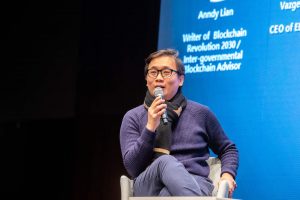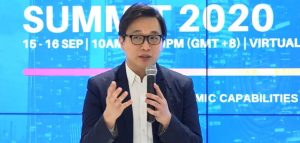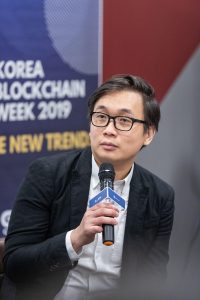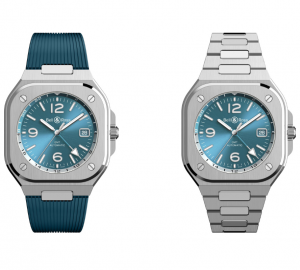NFT (Art): A Primer
Crypto entrepreneur Anndy Lian weighs in on the phenomenal growth of NFTs, and its implications on art creators, vendors and buyers, and the creation of art itself
By Victor Chen, Photos courtesy of Anndy Lian/BigONE Exchange

Posted on 19 May 2022.
In 2020, Christie’s sale of the digital artwork, Everydays – The First 5000 Days by Beeple, for US$69.3 million captured the attention of the public, artists and creators, remarks Anndy Lian, Chairman of BigONE Exchange, provider of a trading platform for various cryptocurrencies.
The NFT trend further intensified with the sale of Larva Labs’s Cryptopunks for US$17 million – and has not waned since, he continues. “Those sales are well known and talked about, but what remains somewhat obscure is how the blockchain-based NFT technology provides a transparent record of price, ownership and authenticity, all of which are well suited to the needs of creators, sellers and buyers in the art market,” Lian remarks.
An NFT is a digital representation of an artwork that is registered or ‘minted’ in a digital database called a blockchain. Among the biggest changes that it is anticipated to bring are the transparency in the ownership and exchange, and the importance of digital art.
“Certainly, for the needs of any growing two-sided marketplace to continue thriving NFTs offer distinctly powerful advantages: for creators, it provides an open network with the opportunity to express one’s creativity and prove ownership, and for collectors, it’s a readily accessible way to own and express their taste in a digitally native world.”
As with investing in cryptocurrency, it’s important, especially when buying an NFT artwork, to ensure it is safe and profitable. This requires doing proper research into the artwork, and setting up an account in a well-known marketplace safely and securely, advises Lian. “It’s important for people to realise that in the NFT world security is one’s own responsibility,” he cautions. “There’s no call center to sort it out for you when things go pear-shaped.”
Safety includes simple but important steps such as using a password manager to create and store one’s passwords for registering with NFT sites like OpenSea or LooksRare, Lian advises. Both marketplaces offer helpful guides to installing and connecting a wallet to the platform, buying an NFT artwork at a fixed price or in an NFT auction, and selling them when the time comes, which includes creating a sale listing to accepting an offer, Lian says. They also provide information on how artists can go about creating their first NFT artwork. “Remember that NFTs do not provide ownership of the underlying digital asset. So, make sure you also have a contract to prove your ownership of the asset itself, in case it is required.
“Ultimately, however, it’s down to participants and collectors to find artists with enduring creative value, not just to make a quick buck on. These will be the most profitable as long-term investments, like investing long-term in cryptocurrency you know will only grow in value such as Bitcoin.”
Lian asserts that understanding what the numbers mean is crucial in assessing the NFT marketplace. “For example, in August last year, OpenSea exceeded $1 billion in gross market volume year-to-date for the first time. By late 2021, it had grown so much that it processed $3.2 billion in volume in the month of December alone. Meanwhile, data shows that OpenSea currently has around 1.75 million users.
“But what’s special about growing this marketplace, supported by the decentralised blockchain technology, is the way it also allows participants to learn about the space from a modest purchase, and the qualitative benefit of being able to connect directly with artists and creators.”
This educates buyers and collectors from these conversations, which builds sustainable value in artist’s work at a human and a market level, Lian reasons. “And with global brands like Nike buying NFT startup RTFKT Studios last year, positioning it as a brand leveraging cutting-edge innovation to create a ’next generation’ collectibles culture, the wider market for creative NFTs is only going to grow further. Indeed, Nike’s virtual sneakers will help deliver an immersive experience in the metaverse—another huge growth area for artist’s NFTs as well as forward thinking brands.”
Tracking Lian

Founded in 2017 and registered in the Netherlands, BigONE operates in Russia, Brazil, Vietnam, Seychelles, Singapore, Japan, and Indonesia, providing marketing, investment, and blockchain technology R&D.
As Chairman, Lian runs the group’s crypto online channels, from Twitter to Reddit, providing insights on such topics as the metaverse, NFTs, and the latest crypto regulation in Singapore as an incentive to get their users involved. For example, BigONE empowers and encourages women to participate in the blockchain space.
Lian also heads the communication for BigONE products, including liquidity mining, and spearheads partnership with select new projects that seek the listing of their token on the BigONE exchange.
Bringing over 15 years of experience in Asia working in various industries for local, international, and publicly traded companies, Lian is concurrently the chief digital advisor at the Mongolian Productivity Organisation and a blockchain investment partner at Passion Venture Capital.
Previously, he served as the blockchain advisor for Asian Productivity Organisation (APO), an intergovernmental organisation and advisory board member to Hyundai DAC, the blockchain arm of South Korea’s Hyundai Motor Group.
SET UP YOUR NFT by Anndy Lian

NFTs are used to acquire an artwork. To do this, a buyer (or a seller) must purchase a well-recognised cryptocurrency, say, Ethereum (ETH for short). An Ethereum is similar to a Bitcoin; however, unlike a Bitcoin, it is designed to support several applications making it the cryptocurrency of choice for acquiring NFTs.
To buy an Ethereum, two things must be set up: a crypto exchange account and a Metamask browser wallet where the Ethereum bought from a crypto exchange will be eventually transferred. The Metamask wallet is what is used in transacting in the NFT marketplace, such as OpenSea, to buy or sell an NFT artwork. Currently, the most popular Metamask browser extension is in the Chrome browser.
Once the Metamask extension has been set up, its address is released to the buyer and the Ethereum is transferred to that wallet address. With the complicated part of the setting up an account out of the way, transactions are fairly easy.
Explore Before Acquiring
A good way to start acquiring NFT artwork is by exploring the market. This is similar to visiting galleries to ascertain what are available for acquisition. Popular marketplaces, such as Opensea, offer many different NFT artworks for sale. Using the access provided in the Metamask wallet, a sale transaction can then proceed. When buying an NFT artwork, both the cost of the NFT as well as the transaction, also known as the ‘gas fee’, are to be paid.
In some cases, especially for NFT artwork that are priced lower, the gas fee can be greater higher, so it’s good to be aware of that from the outset. Once an NFT artwork is bought, it can be sold for a higher price, less 2.5 per cent that goes to OpenSea and a creator royalty that goes to the original creator.
This where NFT artworks contain what’s known as a smart contract, an automated blockchain-based process that gives the artist a percentage of any future sale of the token.
Do Your Homework
To assess whether an NFT artwork is worth buying, a few checks must be made. Firstly, for any given NFT artwork, the selling history must be reviewed. Are people are buying or selling the NFT? If not, and you buy an NFT then you could be stuck with an item that’s hard to sell.
Another good indicator in OpenSea is to look at the overall collection and see how much is being sold, in other words what the volume is. In other words, you want a NFT that has had many buys and sells, that’s what is termed ‘Liquid’ so you can easily sell it if you wish to cash in your investment.
Connected to that you want to see if the NFT over its history has been rising in price. Plus, its worth checking the ‘floor price’ to see the lowest cost of NFTs in a collection, so if you need to sell you can more easily sell if you have a NFT nearer the floor price. Finally, it’s worth Googling the collection’s community, to see how well supported they are in channels such as Discord and Twitter to judge the demand for the NFTs from a creator/artist.






